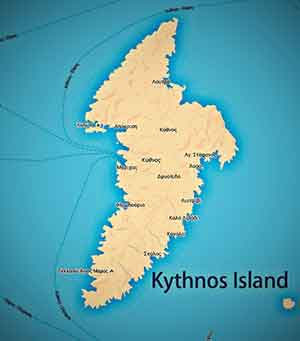Kythnos has several caves mostly small in size except Katafyki cave which is one of the largest caves in the Greek islands. Below we list the most important caves of Kythnos:
The Katafyki Cave
The most famous cave of Kythnos, the Katafyki or Katafigi (Refuge - in Greek) is classified as one of the major attractions available on Kythnos most of which remains unexplored to date.
One encounters the Katafygi cave at the edge of the village Dryopida specifically the north side, at the location of Fires. Situated at an altitude of 190 meters it has a constant temperature of 17 degrees Celsius throughout the year. The length of the mapped natural cave is just over 600 meters and there is a large artificial gallery which was created as a passage for trolleys to transport ore, with a length of two kilometers leading to the Kinidos region (later the area was named: Piadakia). Within the natural cave labyrinthine corridors have developed covering an area of approximately 3,500 sq.m.
It owes its name to a period a few centuries ago, when it functioned as a refuge during the years of pirates, the Franks and the Turkish occupation, as well as the Second World War period. Besides being named Katafyki, it is also called the Cave of Georgiou Martinou (commonly also called: Sympetherouli) the important Kythnian geologist who devoted his life to the study and exploration of the cave.
The cave system consists of several tunnels formed by water over long distances, and that gives the impression of a labyrinth for scientists. The materials the cave is made of are used as construction minerals such as marble, slate and minerals with predominant in Hematite, one of the known minerals of iron ore widely used in jewelry manufacture but also as a basic raw material in blast furnaces. The strong presence of the ore in the cave induced the interest of the locals who mined it for many years in particular from 1835 to 1940.
The cave is adorned with prehistoric stalactites and stalagmites that impress with their volume and form. In essence it is a set of natural galleries created by the flow of an ancient river and artificial tunnels built by the inhabitants of the region in the last century for ore mining purposes.
Starting the tour from the main entrance of the cave, in a few meters we find the "Little Piazza" (small square) which is immediately followed by a larger hall called the "Great Piazza" (large square). To the right of these spaces there are some natural narrow tunnels, one meter wide approximately, with majestic towering vertical walls that impress. These natural tunnels nature composed lead to the "Stalactite Hall" probably the most beautiful part of the cave to visitors. Here you will see a series of stalagmites created over marble which suffered landslides several thousand years ago that reveal the age of the cave. Our elders have bequeathed several names for these stalagmites, names that are very representative of the shape they form. Thus you will distinguish the giant "Tower of Babel", the "Jellyfish or Octopus or Chandelier" (depending on what one sees it as), the "Fetus", and the "Bear." Following the southern direction of the central corridor and returning to the exit, on our right we see a well "hidden maze" with labyrinthine galleries. Continuing on the main path, and again to the right shows a "secret" particularly dangerous, deep chasm. Following the way back and at about 20 meters upward gradient towards the imposing hall of "Gournaki". A natural pond with water dripping for thousands of years creating a unique spectacle. The "Gournaki" emerges between corroded rock formations of incredible beauty, stalagmites and stalactites causing awe and enchantment of the senses of every visitor...
The Katafyki as a separate "hairloom" of Dryopida served at various times as a place of assembly of local events and festivals for the Dryopes. Many references to the celebrations of Easter with the burning of bonfires lighting the interior of the cave.
In recent years a major effort by local authorities has been instituted for tourism development of the cave. Despite this only a very small portion is accessible, but fully capable of charming and fascinating every visitor.
The Karavospilia Cave
Located on the north coast of Kythnos the approach to this cave only by boat. This is an underwater cave that impresses by its colors. If you do not have a boat you should start from Loutra (the Baths) and follow the dirt road to the north and then to the small northern path leading to Kefalos Beach. You should first gather information from locals to explain exactly where the Karavospilia is.
The Legamena Cave
Legamena is a sea cave on the east coast of Kythnos, near the coast. The exact location is known to the fishermen of Panagia Kanala. You can get there only by boat and accompanied by a local who knows the surrounding waters and the location of the cave. The stalagmites that adorn the interior of the cave "Legamena" Kythnos will impress every underwater visitor!
A multitude of underwater caves
Kythnos is one of the favorite islands of divers thanks to the many underwater caves one encounters scattered across the coastline. Most of these caves, usually distant from the coastal settlements, are a first class refuge for several endangered sea seals (Mediterranean Monachus monachus) living today.
Small land caves
In all corners of the island you will encounter several small caves scattered in valleys, mountains, hills or steep slopes. In years past, some of these were used as shelters by shepherds or hunters during heavy downpours. Most of these now, serve as shelters to a small endemic terrestrial creature, the rare Cordioniscus kithnosi, which is among the invertebrates troglovia*, the scientific name of the endangered creature and lives only in Kythnos.
* The troglovia are creatures that only grow in parts of caves and underground environments and were forced by the conditions, to develop special adaptations for survival in their hostile underground environment.
join.booking.com


























